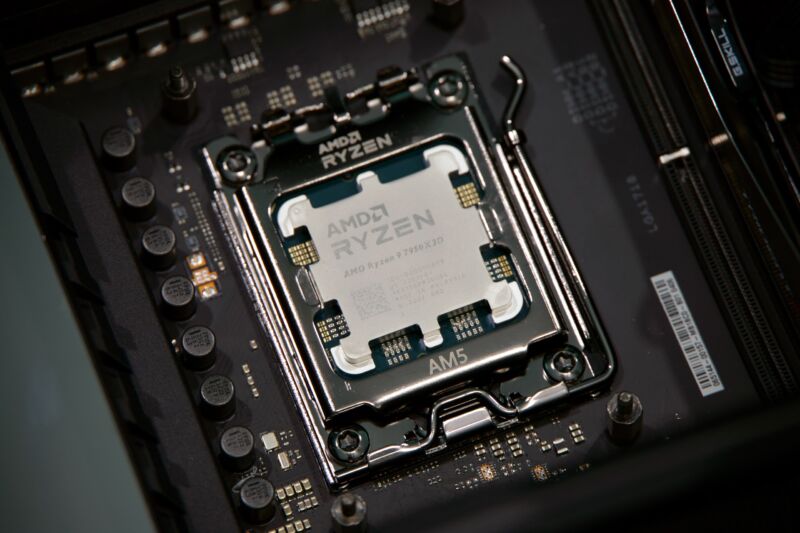
Toward the end of Ryzen 5000's run, AMD released the Ryzen 7 5800X3D, a special version of the eight-core 5800X with 64MB of extra L3 cache stacked on top of it.
The result was an interesting but niche experiment. The extra "3D V-Cache" helped the CPU perform particularly well in games, but lower clock speeds (plus higher power use and heat generation) hurt its all-around app performance. The extra cost was (and remains) way out of proportion to the speed gains over the 5700X or 5800X. And the 5800X3D was the end of the line for the old socket AM4 platform, making it an interesting upgrade option if you already had an older Ryzen PC but an awkward choice to build an all-new PC around.
Now AMD is back with an expanded range of Zen 4-based Ryzen 7000X3D processors. The $599 12-core Ryzen 9 7900X3D and $699 16-core Ryzen 9 7950X3D are available now, while the 8-core Ryzen 7 7800X3D will arrive on April 6.
The expanded scope of the lineup suggests that AMD has gotten more comfortable with the manufacturing end of the equation—3D V-Cache isn't in every Ryzen CPU, but it's also not being restricted to a single product released at a weird point in the Ryzen 7000 life cycle. AMD has addressed some of the 5800X3D's biggest shortfalls by boosting clock speeds, though not always in elegant ways. The CPUs still feel like experiments in some ways, and most people buying or building a PC will be served just fine by one of the cheaper, non-X3D CPUs (or something from Intel). But the performance—and especially the power efficiency—of the 7950X3D makes it worth a look for anyone building a gaming PC that also does double-duty as a video editing rig or a workstation.
Pricing comparisons
The Ryzen 7000 CPU lineup is currently segmented into three sub-categories: the X-series CPUs that were available at launch, non-X-series CPUs for mainstream PCs with lower default power settings and lower prices, and now the expensive, gamer-focused X3D models. Compared to the X series, you're paying somewhere between $100 and $150 more for CPUs that mostly promise improved game performance.
| Current pricing | Cores/threads | Clocks (Base/Boost) | Total cache (L2+L3) | TDP | |
|---|---|---|---|---|---|
| Ryzen 9 7950X3D | $699 | 16c/32t | 4.2/5.7 GHz | 144MB (16+128) | 120 W (162 W PPT) |
| Ryzen 9 7900X3D | $599 | 12c/24t | 4.4/5.6 GHz | 140MB (12+128) | 120 W (162 W PPT) |
| Ryzen 9 7950X | $589 | 16c/32t | 4.5/5.7 GHz | 80MB (16+64) | 170 W (230 W PPT) |
| Ryzen 9 7900X | $448 | 12c/24t | 4.7/5.6 GHz | 76MB (12+64) | 170 W (230 W PPT) |
| Core i9-13900K | $580 | 8P/16E/32t | 3.0/5.7 GHz (P-cores) | 68MB (32+36) | 125 W PL1/253 W PL2 |
| Core i7-13700K | $418 | 8P/8E/24t | 3.4/5.3 GHz (P-cores) | 54MB (24+30) | 125 W PL1/253 W PL2 |
Prices for AMD's other Zen 4 processors have settled a bit since the chips were launched back in September, partly because Intel's 12th- and 13th-generation CPUs have been priced very competitively and partly because CPU and desktop PC sales are way down compared to early in the pandemic (though they're still higher than they were pre-pandemic). If you read our older coverage, you might notice that the 7950X3D is launching at the same price that the regular 7950X launched at less than six months ago; this is presumably not the competitive position AMD wanted to be in this early in Ryzen 7000's life cycle.
Looking at the top of Intel's 13th-generation lineup, the i9-13900K is going for $600 or less these days (normally, the KF or non-K version of the 13900 could save you even more money, but as of this writing, all three are hovering in the same price range). Its main shortcoming is that you need to let it consume a lot of power to get the most out of it, especially compared to the 7950X3D, but in terms of upfront costs, you can still put a top-end Intel system together for a bit less money than an AM5 system.
As we've written before, AMD's platform also mandates a new motherboard with a new socket and chipset and DDR5 memory, while Intel's CPUs work with a wider range of cheaper motherboards, and you can still use DDR4 RAM to save money if you like. But if you're seriously considering a 7950X for your PC, you'd also probably be considering a DDR5-compatible Z690 or Z790 motherboard for an Intel CPU, which closes that price gap a bit. Sticking an i9-13900K in a cheap motherboard with an H610 chipset would technically work, but it's likely that the power delivery system in that motherboard would restrict its performance.
reader comments
123